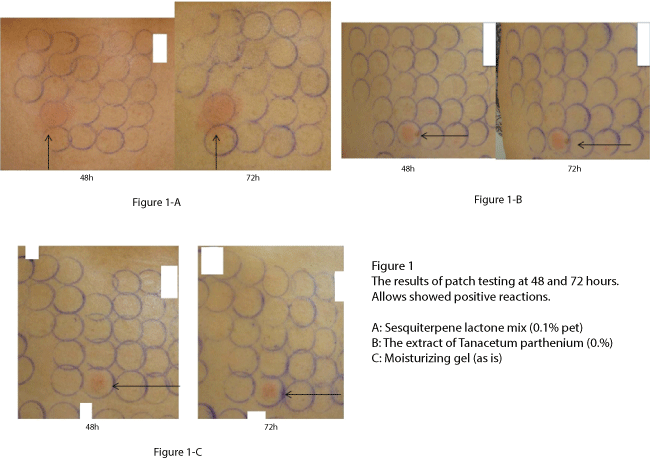International Journal of Allergy Medications
Contact Dermatitis Caused by Tanacetum Parthenium
Mariko Sugiura* and Keiji Sugiura
Department of Environmental Dermatology & Allergology, Daiichi Clinic, Japan
*Corresponding author:
Mariko Sugiura, Department of Environmental Dermatology & Allergology, Daiichi Clinic, Nittochi Nagoya Bld., 2F, 1-1 Sakae 2, Nakaku, Nagoya, 468-0008, Japan, Tel & Fax: +81-52-204-0834, E-mail: msugiura@daiichiclinic.jp
Int J Aller Medcations, IJAM-2-021, (Volume 2, Issue 2), Case Report
Received: September 24, 2016; Accepted: November 25, 2016; Published: November 28, 2016
Citation: Sugiura M, Sugiura K (2016) Contact Dermatitis Caused by Tanacetum Parthenium. Int J Aller Medications 2:021
Copyright: © 2016 Sugiura M, et al. This is an open-access article distributed under the terms of the Creative Commons Attribution License, which permits unrestricted use, distribution, and reproduction in any medium, provided the original author and source are credited.
Abstract
We report the case of a 63-year-old female homemaker with contact dermatitis on her hands caused by extract of Tanacetum parthenium (feverfew). Forty-eight-hour closed patch testing showed positive reactions to sesquiterpene lactone mix (0.1% pet) and extract of Tanacetum parthenium (0.2%). The extract, sesquiterpene lactones of Tanacetum parthenium, is identified as a contact allergen. A member of the chrysanthemum family, feverfew is common worldwide, and there are many products that include extract of sesquiterpene lactones. It is therefore easy to be exposed to sesquiterpene lactones in daily life.
Keywords
Contact dermatitis, Hand, Tanacetum parthenium, Chrysanthemum, Feverfew
Introduction
Tanacetum parthenium is a perennial herb known as feverfew that originated in west Asia or the Balkan Peninsula. These plants now grow in northern Europe, North America and Australia, and include over 500 varieties of chrysanthemum and over 20,000 compositae species [1]. Tanacetum parthenium is often used totreat insect bites, migraines [2-6], irregular menstruation [7], toothache and rheumatoid arthritis [2,7] because the extracts of this plant (feverfew) act as serotonin antagonist [8] and inhibits leukotrienes [9], prostaglandin synthesis, vascular muscle contractility, and histamine release from mast cells [10,11]. In cosmetics, this extract is used in anti-inflammatories and moisturizers. However, extracts of the chrysanthemum family sometimes cause allergic contact dermatitis [12-19], photo contact dermatitis [18,20,21], and air-borne dermatitis [19,20,22,23]. Here, we report a case of contact dermatitis caused by extract of Tanacetum parthenium.
Case
A 63-year-old female homemaker developed dermatitis on her hands approximately seventeen years ago, and steroid ointment did not improve her dermatitis completely. She started to cultivate many Tanacetum parthenium plants approximately 10 years ago, and she used moisturizing gel on her hands after taking care of the flowers.
Her symptoms worsened year by year. Her hands developed xerotic skin, erythema, papules and itching. Our first diagnosis was contact dermatitis due to the moisturizing cream or extract of Tanacetum parthenium. Forty-eight-hour closed patch testing on her back showed positive reactions to sesquiterpene lactone mix (0.1% pet), extract of Tanacetum parthenium (0.2%), and moisturizing gel (as is) (Figure 1) (Table 1) evaluated by the International Contact Dermatitis Research Group (ICDRG) criteria. We recommended that she not cultivate Tanacetum parthenium or use moisturizing gel that includes extract of Tanacetum parthenium. Under this treatment with using steroid ointment and anti-histamine tablets, her skin condition improved.

.
Figure 1: The results of patch testing at 48 and 72 hours. Allows showed positive reactions.
A) Sesquiterpene lactone mix (0.1% pet); B)The extract of Tanacetum parthenium (0.2%); C) Moisturizing gel (as is).
View Figure 1
![]()
Table 1: The results of patch testing (ICDRG criteria).
View Table 1
Discussion
Chrysanthemums comprise one family of over 20,000 composite species [1]. Tanacetum parthenium (feverfew), which belongs to the chrysanthemum family, is known as an important sensitizer in Europe and Asia. However, contact dermatitis due to contact with plants of the chrysanthemum family often develops in growers, flower shop workers and cooks, and is considered a kind of occupational contact dermatitis. The extract, sesquiterpene lactones of Tanacetum parthenium (fever few), is identified as a contact allergen. Because these sesquiterpene lactones have biologic effects, such as antitumor, antibacterial and antifungal activities [1], they are included in many products. Sesquiterpene lactones are a kind of terpenoid, and over 3,000 sesquiterpene lactones have been identified, of which more 1,350 appear in the compositae family [18,24]. Over 100 sesquiterpene lactones are potential allergens [1]. Feverfew contains high amounts of allergenic sesquiterpene lactones as measured by spectrophotometry, and shows a high incidence of allergic patch test-positive reactions [25]. Chrysanthemum species, chamomile, artichokes, wormwood, sneezeweed, ragweed and poverty weed all cause allergic contact dermatitis due to sesquiterpene lactones [26].
Sesquiterpene lactones have seven different kinds of chemical structure [25], and a sesquiterpene lactone mix is used for patch testing. Other kinds of plants that include sesquiterpene lactones may show cross reactions. Alpha-methylene γ-butyrolactone ring has been identified as a main allergen in sesquiterpene lactones of the compositae family [24,25,27].
The chrysanthemum family, feverfew, is common worldwide, and it is therefore easy to be exposed to sesquiterpene lactones in daily life.
References
-
James G M Jr, Peter Elsner, Vincent Deleo, Mosby Inc (2002) Contact & occupational dermatology. St louis, USA, 268-271.
-
Fischedick JT, Standiford M, Johnson DA, De Vos RC, Todorović S, et al. (2012) Activation of antioxidant response element in mouse primary cortical cultures with sesquiterpene lactones isolated from Tanacetum parthenium. Planta Med 78: 1725-1730.
-
Johnson ES, Kadam NP, Hylands DM, Hylands PJ (1985) Efficacy of feverfew as prophylactic treatment of migraine. Br Med J (Clin Res Ed) 291: 569-573.
-
Murphy JJ, Heptinstall S, Mitchell JR (1988) Randomised double-blind placebo-controlled trial of feverfew in migraine prevention. Lancet 2: 189-192.
-
Palevitch D, Earon G, Carasso R (1997) Feverfew (Tanacetum parthenium) as a prophylactic treatment for migraine: a double-blind placebocontrolled study. Phvtother Res 1: 508-511.
-
De Weerdt CJ, Bootsma HP, Hendriks H (1996) Herbal medicines in migraine prevention Randomized double-blind placebo-controlled crossover trial of a feverfew preparation. Phytomedicine 3: 225-230.
-
Rotblatt MD (1999) Cranberry, feverfew, horse chestnut, and kava. West J Med 171: 195-198.
-
Marles RJ, Kaminski J, ArnasonJT, Pazoa-Sanou L, Heptinstall S, et al. (1992) A bioassay for inhibition ofserotonin release from bovine platelets. J Nat Prod 55: 1044-1056.
-
Sumner H, Salan U, Knight DW, Hoult JR (1992) Inhibition of 5-lipoxygenase and cyclo-oxygenase in leukocytes by feverfew. Involvement of sesquiterpene lactones and other components. Biochem Pharmacol 43: 2313-2320.
-
US Pharmacopeia (1997) Feverfew. Botanical Monograph Series: USP DI® Information for the Health Care Professional and Consumer. Rockville, MD.
-
Hausen BM (1992) Sesquiterpene lactones-Tanacetum parthenium. In: De Smet PAGM, editor, Adverse effects of herbal drugs 1: 255-260.
-
Paulsen E, Søgaard J, Andersen KE (1998) Occupational dermatitis in Danish gardeners and greenhouse workers (III). Compositae-related symptoms. Contact Dermatitis 38: 140-146.
-
Wakelin SH, Marren P, Young E, Shaw S (1997) Compositae sensitivity and chronic hand dermatitis in a seven-year-old boy. Br J Dermatol 137: 289-291.
-
Bleumink E, Mitchell JC, Geismann TA, Towers GH. Contact hypersensitivity to sesquiterpene lactones in Chyrsanthemum dermatitis.Contact Dermatitis 2: 81-88.
-
Picman J, Picman AK (1990) Treatment of dermatitis caused by the sesquiterpene lactone helenin. Pharmazie 45: 57-59.
-
Campolmi P, Sertoli A, Fabbri P, Panconesi E (1978) Alantolactone sensitivity in chrysanthemum contact dermatitis. Contact Dermatitis 4: 93-102.
-
Fernandez de Corres L (1984) Contact dermatitis from Frullania, Compositae and other plants. Contact Dermatitis 11: 74-79.
-
Lamminpaa A, Estlander T, Jolanki R, Kanerva L (1996) Occupational allergic contact dermatitis caused by decorative plants. Contact Dermatitis 34: 330-335.
-
Paulsen E, Christensen LP, Andersen KE (2002) Do monoterpenes released from feverfew (Tanacetum parthenium) plants cause airborne Compositae dermatitis? Contact Dermatitis 47: 14-18.
-
Kar HK, Langar S, Arora TC, Sharma P, Raina A, et al. (2009) Occurrence of plant sensitivity among patients of photodermatoses: a control-matched study of 156 cases from New Delhi.Indian J Dermatol Venereol Leprol 75: 483-487.
-
Frain-Bell W, Hetherington A, Johnson BE (1979) Contact allergic sensitivity to chrysanthemum and the photosensitivity dermatitis and actinic reticuloid syndrome. Br J Dermatol 101: 491-501.
-
Christensen LP, Jakobsen HB, Paulsen E, Hodal L, Andersen KE (1999) Airborne Compositae dermatitis: monoterpenes and no parthenolide are released from flowering Tanacetum parthenium (feverfew) plants. Arch Dermatol Res 291: 425-431.
-
Aleksander O, Grazyna A, Anna WP (2014) Air-borne dermatitis from Chrysanthemum--case report with a discussion of diagnostic procedures and therapy. Ann Agric Environ Med 21: 531-533.
-
Mensing H, Kimmig W, Hausen BM (1985) [Airborne contact dermatitis]. Hautarzt 36: 398-402.
-
Salapovic H, Geier J, Reznicek G (2013) Quantification of Sesquiterpene Lactones in Asteraceae Plant Extracts: Evaluation of their Allergenic Potential. Sci Pharm 81: 807-818.
-
Mitchell JC, Dupuis G (1971) Allergic contact dermatitis from sesquiterpenoids of the Compositae family of plants. Br J Dermatol 84: 139-150.
-
Hausen BM, Vieluf IK (1997) Allergiepflanzen, Pflanzenallergene.





